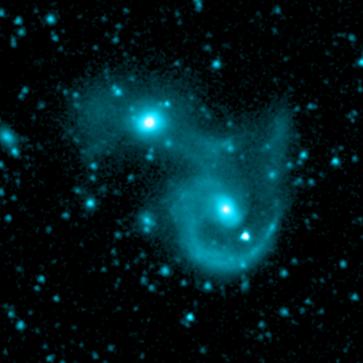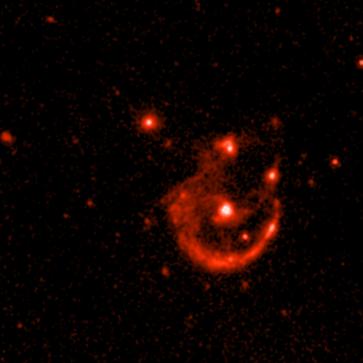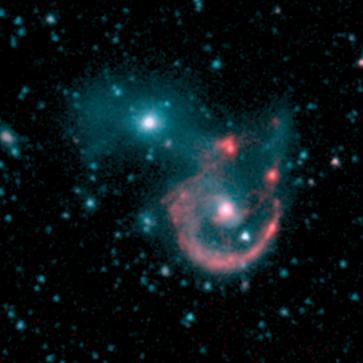


Click here for tif image.
NASA's Spitzer telescope's sensitive infrared detectors map out faint regions of new star formation in this pair of colliding galaxies known as Arp 107. Like a beautiful pearl necklace, young star clusters have formed along the ring-like tidal arm in this system. Spitzer images at 8 microns (second picture above) provide a clear view of these clumps of young stars. In contrast, in the shorter wavelength 3.6 micron band (first picture), the older stars in the small companion to the northeast and the bridge connecting the two galaxies are bright. The color-coded multi-band picture (third picture; red=8.0 microns, blue=3.6 microns) emphasizes this difference in stellar ages.
North is up and east is to the left on these images. The field of view is 3 arcminutes.
These Spitzer images were presented at the American Astronomical Society meeting in Minneapolis, Minnesota, on May 30, 2005. A journal article with a detailed analysis of these maps has been submitted to the Astronomical Journal. This research has been sponsored by NASA.
Contact: Beverly Smith, East Tennessee State University, Department of Physics, Astronomy, and Geology, (423) 439-8418, smithbj@etsu.edu
PHOTO CREDIT: NASA/JPL-Caltech/B. J. Smith, C. Struck, P. N. Appleton, V. Charmandaris and W. Reach.
NASA's Jet Propulsion Laboratory, Pasadena, Calif., manages the Spitzer Space Telescope mission for NASA's Science Mission Directorate, Washington, D.C. Science operations are conducted at the Spitzer Science Center, California Institute of Technology, Pasadena, Calif. JPL is a division of Caltech.